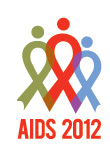 Only one in three people living with HIV in the United States are being retained in care—being seen by a health care provider on a regular basis—according to sobering new U.S. Centers for Disease Control and Prevention (CDC) data presented Friday, July 27, at the XIX International AIDS Conference. The latest results, focusing specifically on race, gender and age differences, contribute to growing awareness regarding a significant problem in the U.S.—the poor engagement of HIV-positive people in the continuum of care required to prolong disease-free survival and curtail the ongoing spread of the virus.
Only one in three people living with HIV in the United States are being retained in care—being seen by a health care provider on a regular basis—according to sobering new U.S. Centers for Disease Control and Prevention (CDC) data presented Friday, July 27, at the XIX International AIDS Conference. The latest results, focusing specifically on race, gender and age differences, contribute to growing awareness regarding a significant problem in the U.S.—the poor engagement of HIV-positive people in the continuum of care required to prolong disease-free survival and curtail the ongoing spread of the virus.
Using data from the National HIV Surveillance System and the Medical Monitoring Project, H. Irene Hall, PhD, of the CDC and her colleagues set out to examine the proportion of people living with HIV in various subgroups—stratified by race, gender, age and HIV risk group—who are engaged at each stage of the HIV care continuum: those who have been tested, linked to a care provider, remaining in care, prescribed antiretroviral (ARV) treatment and having a suppressed viral load.
H. Irene Hall, PhD, presented combined data from the National HIV Surveillance System (NHSS) and the Medical Monitoring Project to estimate overall HIV prevalence, the number of diagnosed and undiagnosed infections, the percentage of HIV-positive people linked to care, retained in care, prescribed antiretroviral treatment, and the number of people with viral suppression. (Viral suppression was defined as documentation in a medical record of the most recent viral load as undetectable or less than or equal to 200 copies per mL.)
Hall first presented what amounted to a census of U.S. residents living with HIV using available surveillance data. According to her overview, 1,148,200 people in the U.S. were estimated to be living with HIV in 2009, more than 200,000 of whom had not been tested.
Continuing down the continuum, Hall said that 66 percent of all people living with HIV in the U.S. have been linked to care, 37 percent have been retained in care, 33 percent have been prescribed antiretroviral therapy and 25 percent—one in four people living with HIV—had very low viral loads.
“The big drop off is in retaining people in care, and there may be many factors to [explain] why that is happening,” Hall said.
Looking specifically at race and ethnicity data, Hall explained that black people living with HIV are least likely to be in ongoing care and to have their virus under control. Thirty-four percent of blacks were in ongoing care, compared with 38 percent of whites. Twenty-one percent of blacks had undetectable viral loads, compared with 30 percent of whites.
Latinos were being retained in care and were receiving antiretroviral therapy at similar rates compared with whites. However, they were less likely to know their HIV status and were less likely to have undetectable viral loads (26 percent versus 30 percent, respectively).
When considering sex and transmission category, Hall and her colleagues found that females were more likely to be receiving care and to have been prescribed antiretroviral therapy compared with males. And while 26 percent of women and men who have sex with men (MSM) have undetectable viral loads, only 19 percent of males reporting heterosexual sex as their risk factor and 22 percent of males reporting injection drug use as their risk factors had suppressed viral loads.
Treatment and care for younger U.S. residents was another area of concern. For example, 15 percent of those between 25 and 34 years of age had undetectable viral loads, compared with 36 percent of those between 55 and 64 years of age. In terms of regular care, 28 percent of those between 25 and 34 years of age were retained in care, compared to 46 percent of those between 55 and 64 years of age.
Although national data were not available to provide undetectable viral load rates among those under the age of 25, Hall and her colleagues reported data indicating that 13- to 24-year-olds are substantially less likely to have been diagnosed with HIV than other age groups (41 percent versus more than 70 percent for all other age groups).
“Increasing the percentage of young [people] diagnosed and in continuous care is critical to address HIV in the U.S.,” Hall concluded. She acknowledged that recent changes to treatment guidelines must also be considered when interpreting these results, since at the time of the study treatment guidelines did not recommend early antiretroviral therapy. Hall explained that under the former recommendations when HIV-positive people were relatively healthy, especially young people, they were less likely to be prescribed antiretroviral therapy.
Hall said that changing the treatment guidelines to favor early antiretroviral therapy was a move in the right direction. However, “to realize the full potential of prevention through treatment,” she suggested that improvements need to be made at each stage of the continuum of care. “Insuring that people stay in care and on treatment will increase the proportion of HIV-infected individuals who achieve and maintain a suppressed viral load.”
Advertisement
Advertisement
Advertisement






1 Comment
1 Comment